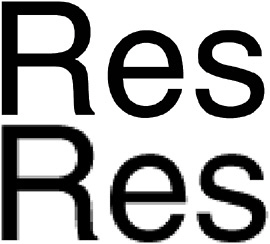Rasterizing Type
Photoshop uses vector-based fonts that preserve the ability to edit the text throughout the imaging process. After you ve generated the text, you can scale it and apply any layer style to it. You can also warp it or change its color. There are, however, certain operations such as filters and color adjustments that don t work on vector-based type. If you want to apply those effects, you ll have to rasterize the type, or convert it into pixels.
Pixel-based type has its advantages and disadvantages. The main disadvantage is that after you render your type, it appears at the same resolution as the document. This is particularly problematic for small type on low-resolution documents, because there might not be enough pixels to do a decent job of smoothing the type s edges (as seen in the sample in Figure 8.20).

Figure 8.20: Crisp, vector-based type (top), and jagged, rasterized type (bottom)
The advantage of pixel-based type is that it enables you to apply effects to the image as you please , such as pasting images into the type or applying a variety of filters to it. To render your type into pixels, target the Type layer and choose Layer ’ Rasterize ’ Type.
EAN: 2147483647
Pages: 355